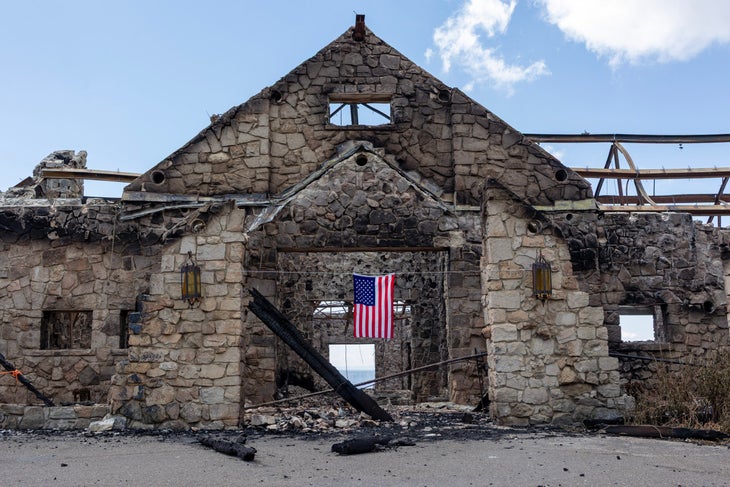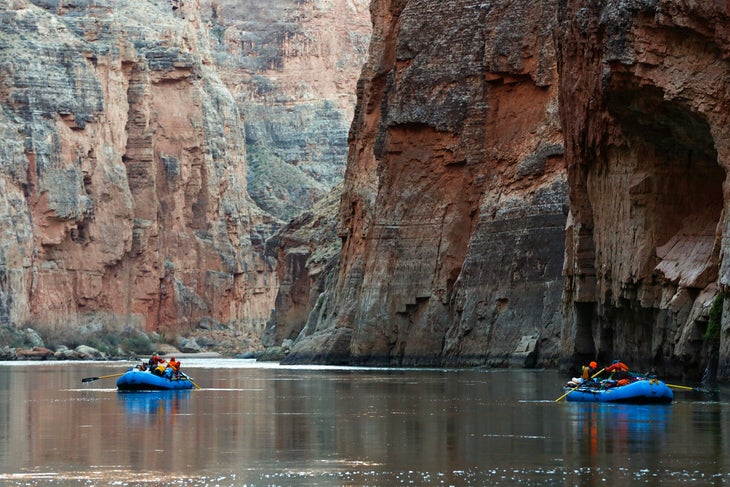The Dragon Bravo wildfire continues to burn on the northside of Grand Canyon National Park, closing access to visitor services on the canyon’s North Rim for the remainder of the season. As of July 24, the blaze had scorched 23,082 acres, making it the largest active wildfire in a national park so far this season, and the fifth-largest in recent history.
According to Rob Roy Williams, the Operations Section Chief for the Southwest Area Incident Management Team, the fire is currently 26 percent contained, with 998 people fighting to keep it under control.
Fortunately, the South Rim—which contains the bulk of the Grand Canyon National Park’s accommodations, restaurants, and tourist attractions—hasn’t been affected. “The news headlines are a bit confusing, but the Grand Canyon is not closed,” Joelle Baird, Grand Canyon National Park’s Public Affairs Officer, told Outside. “The South Rim is open and welcoming visitors as usual.”
There are some caveats. Whether you’re going hiking, camping, whitewater rafting, sight-seeing, or all of the above, here’s what you need to know if you’re planning to visit the Grand Canyon in 2025.
Where Is the Fire in the Grand Canyon?
On July 4, in the wilderness of northern Arizona, lightning ignited what became known as the Dragon Bravo fire. Wildfires in that region are part of the natural ecology, and Dragon Bravo was not initially considered a threat to infrastructure. But wind and weather conditions changed and the fire rapidly grew in size and intensity. By June 11, Dragon Bravo had reached the developed area of the North Rim of the Grand Canyon.
The North Rim is a remote, mostly undeveloped section of Grand Canyon National Park, located a four-hour drive from the tourist amenities on the South Rim. According to Baird, the North Rim sees only about 10 percent of the Grand Canyon’s 5 million annual visitors.
The Dragon Bravo fire’s status is updated daily on the Wildland Fire Application Information Portal. Williams also gives a daily operations update by video, and posts it on the Southwest Area Incident Management Team’s Facebook page.
On July 9, lightning ignited a second wildfire, the White Sage fire, on the Kaibab Plateau, located about 35 miles north of the Dragon Bravo fire (and the Grand Canyon’s North Rim), near the Arizona-Utah border. The fire is not currently threatening Grand Canyon National Park. As of July 24, White Sage had burned 58,980 acres and was 75 percent contained.
What Damage Has the Fire Done to the Grand Canyon?
On July 12, the Dragon Bravo Fire destroyed the only guest lodge on the North Rim, the Grand Canyon Lodge, a National Historic Site. In addition to the iconic main lodge overlooking the canyon, the fire also burned a portion of the lodge’s 100-plus guest cabins.
The flames also engulfed more than a dozen Grand Canyon National Park employee residences, along with administrative offices and storage sheds. “The full damage assessment has not been completed, but the estimate is 70 to 80 total structures,” Baird said.

No lives were lost. Park staff and guests had already been evacuated from the North Rim. But the loss of the iconic Grand Canyon Lodge, which dates back to the 1920s, is profound. The lodge’s owner said in a statement, “As stewards of some of our country’s most beloved national treasures, we are devastated by the loss of the Grand Canyon Lodge and numerous other historic buildings at the Grand Canyon’s North Rim. We are grateful that all our employees and guests have been safely evacuated, and we join the National Park Service in mourning the loss of these iconic and beloved structures.”
Why Are There Closures on the Bottom of the Grand Canyon?
Phantom Ranch, the only lodging at the bottom of the Grand Canyon, and the adjacent Bright Angel Campground are currently closed to both park staff and the public because of poor air quality from the fire. “We have had several very large spikes in unhealthy air quality down at the bottom of the canyon due to smoke inversions,” Baird said.
Phantom Ranch and Bright Angel Campground were initially closed on July 12, when the Dragon Bravo fire burned Grand Canyon National Park’s water treatment facility on the North Rim, leaking chlorine gas into the air.
As explained in the park’s July 13 news release: “Chlorine gas is heavier than air and can quickly settle into lower elevations such as the inner canyon, posing a health risk. Due to the risk of exposure, park authorities immediately evacuated firefighters from the North Rim and hikers from the inner canyon, and closed access to specific areas within the inner canyon. All river trips were instructed to bypass Phantom Ranch.”
Baird confirmed that the chlorine gas was no longer an issue. “In general, during warm temperatures, chlorine gas dissipates really quickly,” she said. “We had a hazmat team from Flagstaff come in and do assessments last week. They determined that it is no longer an active threat for chlorine gas exposure.”
The issue is now the smoke inversion. Baird said the park has set up air quality monitoring equipment on the inner canyon floor and is monitoring it daily. The intent is to open Phantom Ranch and Bright Angel Campground as soon as air quality levels are consistently safe.
The three trails that lead to these amenities, including the North Kaibab Trail, the South Kaibab Trail, and the Bright Angel Trail below Havasupai Gardens, are also closed until the inner canyon air quality improves.
Can You Still Hike the Grand Canyon Rim-to-Rim?
The traditional route for hiking the Grand Canyon rim-to-rim is to take the North Kaibab Trail to either the South Kaibab or Bright Angel trails. With the current closures, this route is no longer an option.
It is possible to hike rim-to-rim using alternate trails, but Baird advises against it. She said that while the distances may be similar, the alternative pathways are more strenuous. “They have a lot of exposure, they’re in the full sun, they don’t have water along them, and they don’t have emergency phones.”
Baird added, “It’s best to wait for inner canyon air quality to improve so you can use the standard corridors.”
Can You Still Whitewater Raft in the Grand Canyon While There’s a Fire?
For whitewater-rafting tour operators, the Dragon Bravo fire hasn’t been a factor, and isn’t expected to have any negative impacts this season. The Colorado River, which flows for 277 miles through the canyon floor, is more than 5,000 feet below the burning on the North Rim. “Our trips are not affected by the fires at all,” Art Thevenin, veteran river guide and manager of Grand Canyon Expeditions, told Outside.

Thevenin said there has been a small amount of smoke, depending on the wind pattern, but not enough to be concerning. “From what we’re seeing, we’re not having any abnormal effects from the fires,” he said. Thevenin recommends that guests with serious respiratory issues check with their doctor.
For guests traveling the river on DIY trips, remember that Phantom Ranch in the inner canyon is closed due to air quality, which means there’s no longer a ranger stationed there, or access to the small clinic. “River trips are going to have to be even more self-sufficient because there is not any staffing down at Phantom Ranch at this time,” Baird said.
What Is Safe to Do at the Grand Canyon?
The South Rim of the Grand Canyon has not been affected by the fire. All of the South Rim’s half-dozen hotels and lodges are open. The South Rim Visitor Center is running its regular programming and ranger-led activities, from nature walks to star-gazing. Nothing has changed at the Yavapai Geology Museum (or its stunning vantage point).
“As tragic as it is that we lost the Grand Canyon Lodge on the North Rim and a lot of the historic buildings up there, over here on the South Rim, we thankfully have the world’s greatest fire block between us and the fire,” Grant Mohn, co-owner of Grand Canyon Adventures, told Outside.
Mohn says all the trails on the South Rim, with the exception of the South Kaibab Trail, are open, as are the campgrounds. The only difference on the South Rim is that Grand Canyon National Park has upgraded its normal summertime fire restriction from Stage 1 to a Stage 2. Under Stage 1, you can only have a campfire in a designated campfire ring. Under Stage 2, no fire of any kind is allowed in the park, including campfires, barbeque grills, and smoking.
Baird encourages visitors who had trips planned to the North Rim to consider the South Rim instead. “We have rooms available and vacancies at all the lodges on the South Rim,” she said.
Travelers can check Grand Canyon National Park’s webcams for real-time conditions, and stay updated on closures and alerts on its website.
